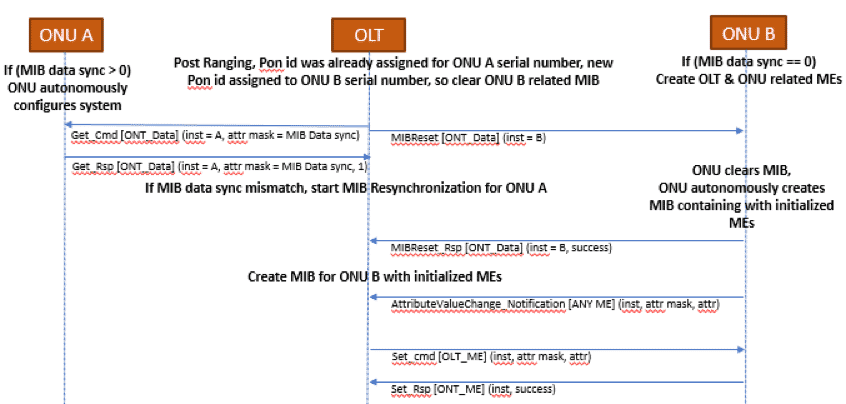Let’s take a glance under the hood of OMCI (ONU Management Control Interface) to look at some of the common services like ONU (Optical Network Unit) synchronization, discovery, circuit-pack provisioning, software image download and change.
ONU Synchronization
The OLT (Optical Line Terminal) manages and controls the ONUs using OMCI messaging. The ONUs are represented in the OLT as MEs (Managed Entities) in a MIB (Management Information Base) stored in the OLT. The MIB is essentially a database used for managing the entities in a communication network. The ONU also maintains a similar MIB locally.
The OLT MIB and the instances of the MEs in the ONU always must be in-sync. This is achieved using the data sync attribute, a global 8-bit sequence number for each ONU. The OLT requests for this sequence number from the ONU and compares it with the corresponding sequence number stored in the OLT. This procedure is called MIB audit. The MIB audit procedure will be performed periodically based on operator’s requirement, on demand and on loss and re-establishment of the OMCC (Operation and Maintenance Channel).
If the sequence numbers are the same, the MIBs are in-sync and no further action is necessary. If not, the MIBs would need to be brought back in-sync by either the OLT downloading its copy of the MIB to the ONU or by the OLT uploading the MIB of the ONU, comparing it with its own MIB and sending necessary commands to ONU to correct the inconsistencies. The MIB audit procedures are illustrated below.

Figure 1 : MIB Audit and resynchronization
ONU Discovery
ONU discovery involves the ONU Activation in co-operation with the OLT to attain synchronization, establish the PLOAM (Physical Layer OAM) channel and achieve ranging. Ranging is a procedure to measure the logical distance between the OLT and each of its subtending ONUs in order to accurately time individual ONU upstream transmission bursts to avoid collisions. This is performed by the TC (Transmission Convergence) Layer.
After ranging, the OLT treats the ONU as old or new based on the PON Identifier assigned to the ONU’s serial number. If it is an old ONU, the OLT starts a MIB audit and resynchronizes the ONU if necessary. If it is a new ONU, the OLT starts a MIB reset. As the ONU learns the attribute values for its MEs, it notifies the OLT and the OLT sets them using OMCI commands. The OMCI part of the ONU discovery process is illustrated in the figure below.

Figure 2: ONU Discovery
Circuit Pack Provisioning
Provisioning and de-provisioning of a circuit pack can be triggered on-demand (by the operator) or plug-n-play (when the card insertion/removal is detected). Provisioning and de-provisioning is always initiated by the OLT on the ONU using OMCI commands. On de-provisioning all the MEs created during provisioning are deleted.
The OLT initiates the provisioning/de-provisioning using the ‘set’ command for the Cardholder The Cardholder represents the fixed equipment slot configuration of the ONU. The ONU responds with a ‘set’ response. Incorrect and empty slot configurations are communicated back to the OLT by the ONU using Alarm notifications. For plug-n-play provisioning/de-provisioning, attribute value change notifications are used by the ONU to notify the OLT once a circuit pack is inserted into or removed from the ONU. Subsequently the OLT sends a ‘create’ or ‘delete’ command to the ONU to provision or deprovision the circuit pack as appropriate.
Software Image Download, Activate and Commit
Download of a software image to the ONU is based on a segmented “stop and wait” protocol. The image is downloaded in segments and the next segment can only be transmitted if the previous segment has been positively acknowledged. A software image segment consists of one or more software image sections. Each section is transmitted by an OMCI message.
The number of sections in a segment is pre-negotiated. The OLT proposes a segment size and the ONU can reduce the segment size in its response. The last image section is an acknowledgement. If the ONU processed all sections of a segment properly, the acknowledgement is positive, after which the OLT will download the next segment. If an error occurred with a section of the segment, then entire segment will be retransmitted.
When the last segment transferred is positively acknowledged, the OLT sends a CRC-32 to the OLT in the software image ‘end download’ command. If the transmitted CRC matches the CRC computed by the ONU on the downloaded image, the image is considered valid. After validation check is acknowledged, the OLT updates its MIB and activates the image with an OMCI command and the ONU restarts with the downloaded image. After a successful start-up sequence, the OLT explicitly commits the active software image and the MIBs are updated at the ONU and OLT.
Closing the hood
This was a glimpse at some of the common operations performed using OMCI messaging. If this has whetted your appetite, feel free to take a deeper look under the hood at the G984.4 and G988 standards. Over the years, working in close collaboration with our partners, IP Infusion has developed the expertise that helps our customers in addressing the challenges of implementing OMCI and bringing innovative solutions to the market.

